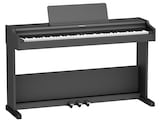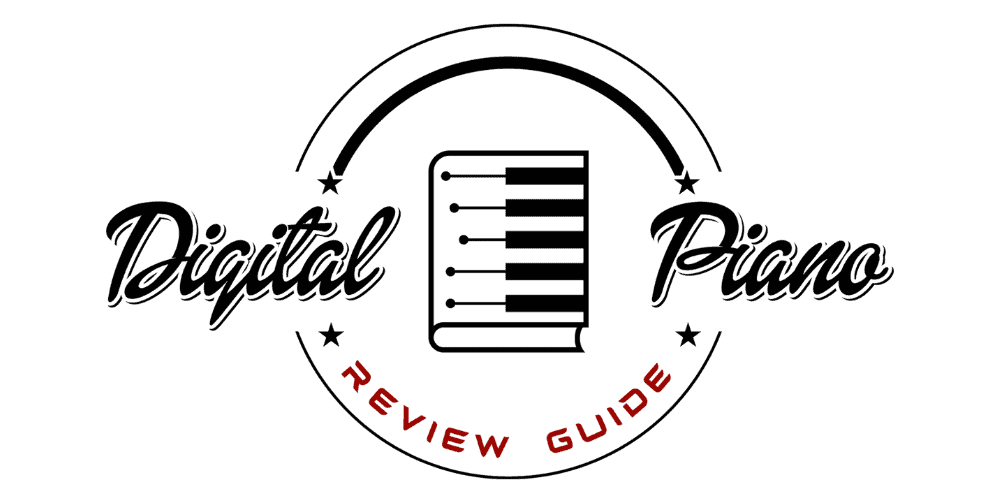Roland RP30 vs Roland RP-102: Which Piano is Better?

Navigating the world of digital pianos can be challenging, with countless models and brands to choose from. Selecting the right instrument that aligns with your budget, skill level, and personal preferences can challenging process. That’s why, in this article, we will compare the Roland RP30 vs Roland RP-102, comparing everything from price and key action to notable features each piano possesses.
| PHOTO | PIANO |
|---|---|
 | Roland RP30 |
 | Roland RP-102 |
 | Roland RP-107 |
 | Yamaha YDP-165 |
 | Casio PX-870 |
Roland RP30 vs Roland RP-102

Our detailed analysis points to the Roland RP-102 as the superior option when comparing it to the Roland RP30. Our recommendation stems from three critical factors that set the Roland RP-102 apart are:
- Authentic acoustic piano experience
- PHA-4 Standard keyboard action
- SuperNATURAL Piano sound technology
These features enable the RP-102 to accurately replicate the touch and tone of an acoustic piano, providing an engaging and realistic playing experience for players of all skill levels.
As we continue, we’ll explore the key differences between these digital pianos in terms of price, key action, sound quality, and unique features, helping you understand why the Roland RP-102 is the top choice.

| BEST SELLERS |
|---|
| 1) Casio PX-770 |
| 2) Yamaha YDP-145 |
| 3) Roland RP-701 |
| 4) Yamaha YDP-165 |
| 5) Casio PX-870 |
- You Might Also Like: Korg Kross 2 vs Roland JUNO DS88
Price
The first factor to consider when comparing the Roland RP30 and the Roland RP-102 is the price. Both pianos are in the entry-level range of Roland’s digital piano lineup, offering excellent value for money for beginners and intermediate players.
The Roland RP30 is priced at $900. The RP30 falls within the lower range of digital pianos, making it an attractive option for those on a tighter budget or looking for an affordable introduction to the world of digital pianos. Keep in mind that the lower price point may mean fewer features and a more basic performance compared to higher-priced models.
The Roland RP-102 is priced around $1,000. The RP-102 is positioned as a mid-range digital piano with more advanced features and improved performance. As a result, it comes with a higher price tag compared to the RP30.
Although it may require a larger investment, the RP-102’s superior features and playing experience may justify the extra cost, especially for those who want a digital piano that can support their growth as a player in the long run.
In summary, the Roland RP30 is a more budget-friendly option, while the Roland RP-102 offers better performance and features at a higher price. It’s essential to consider your budget and priorities when choosing between these two digital pianos.
- You Might Also Like: Roland FP-60X vs Roland FP-90X
Portability
Both the Roland RP30 and the Roland RP-102 are console-style digital pianos, meaning they come with a fixed stand and pedals. They are not designed to be portable instruments like keyboards or stage pianos.
As a result, neither the Roland RP30 nor the Roland RP-102 is suitable for gigging musicians who need to transport their instrument to different locations. Both pianos are well-suited for home use or other situations where the piano will remain in one place.
- You Might Also Like: Casio PX-S1100 vs Roland FP-30X
Key Action

Key action is a crucial aspect to consider when choosing a digital piano, as it significantly influences the instrument’s feel and playability. The Roland RP30 and Roland RP-102 each have distinct key actions that cater to different player preferences.
The Roland RP30 features Roland’s Ivory Feel-G keyboard action, a well-regarded mechanism known for its natural touch and precise response. The Ivory Feel-G keyboard action incorporates a fully weighted, graded hammer action that simulates the feel of an acoustic piano.
The keys are also coated with a moisture-absorbing material, replicating the texture of real ivory and ebony. This added detail enhances the playing experience by providing a more comfortable and secure grip on the keys.
In contrast, the Roland RP-102 boasts the more advanced PHA-4 Standard keyboard action, which is designed to provide an even more authentic piano-playing experience. The PHA-4 Standard action features a fully weighted, graded hammer action and escapement simulation, which reproduces the subtle “click” feel of a grand piano’s keys.
Furthermore, the PHA-4 Standard incorporates Roland’s latest touch-detection technology with high-resolution sensing, ensuring expressive and responsive performance even when playing delicate passages.
In summary, both pianos have authentic key actions, but the Roland RP-102’s PHA-4 Concert key action is more advanced and provides a more expressive playing experience.

| PHOTO | PIANO |
|---|---|
 | Roland RP30 |
 | Roland RP-102 |
 | Roland RP-107 |
 | Yamaha YDP-165 |
 | Casio PX-870 |
- You Might Also Like: Best Key Action?
- You Might Also Like: Best Roland Digital Piano?
Sound
The sound quality of a digital piano is another critical factor to consider, as it directly affects the enjoyment and satisfaction of playing the instrument. Both the Roland RP30 and the Roland RP-102 feature Roland’s renowned SuperNATURAL Piano sound engine, but there are subtle differences in the implementation and additional sound features that set them apart.
The Roland RP30 utilizes the SuperNATURAL Piano sound engine to deliver rich, expressive, and realistic piano tones. This advanced sound engine combines meticulously sampled acoustic piano sounds with sophisticated modeling technology, allowing for an authentic and organic sound reproduction.
The RP30 also offers a variety of instrument tones, such as electric pianos, organs, and strings, which can be layered or split across the keyboard, giving players the flexibility to explore different sound combinations and textures.
On the other hand, the Roland RP-102 not only incorporates the SuperNATURAL Piano sound engine but also features an enhanced sound library with more instrument tones and higher-quality samples. This expanded sound selection provides players with greater versatility in their performances, from classical to contemporary styles.
Additionally, the RP-102 includes Roland’s Headphones 3D Ambience technology, which optimizes the sound experience when playing with headphones. This innovative feature creates a more immersive and realistic soundstage, making it feel as if the sound is emanating directly from the instrument rather than the headphones.
While both the Roland RP30 and the Roland RP-102 are equipped with the SuperNATURAL Piano sound engine, the RP-102 offers a more extensive sound library and additional sound-enhancing features such as the Headphones 3D Ambience technology.
These factors contribute to a more versatile and satisfying playing experience on the Roland RP-102, especially for players seeking a wider range of sounds and a more immersive headphone experience.
- You Might Also Like: Roland F-107 vs Roland RP-107
Notable Features
In addition to key action and sound, there are other notable features that distinguish the Roland RP30 and the Roland RP-102.
The Roland RP30 includes:
- A built-in metronome for practicing rhythm and timing.
- USB-to-Host connectivity for easy integration with computers and mobile devices.
- Twin Piano mode, which enables two players to play simultaneously on the same instrument.
The Roland RP-102 includes:
- A built-in song library with over 200 songs for learning and practice.
- Bluetooth connectivity for wireless integration with computers and mobile devices, as well as compatibility with popular music apps.
- Twin Piano mode, just like the RP30.
- An onboard song recorder to capture your performances and practice sessions.
Ideal Piano for Certain Players
Both the Roland RP30 and the Roland RP-102 cater to a wide range of players, from beginners to more advanced pianists. However, there are some differences between the two models that may influence a player’s decision, depending on their skill level and playing needs.
The Roland RP30 is an excellent choice for beginners, with its comfortable PHA-4 Standard key action and more affordable price. The RP30’s features, such as the built-in metronome and Twin Piano mode, make it a suitable instrument for learning and practicing. However, its lower polyphony and more basic key action might not be ideal for more advanced players looking for a more expressive instrument.
In conclusion, both the Roland RP30 and the Roland RP-102 cater to a variety of players, from beginners to more advanced pianists. The RP30 is a more budget-friendly option with solid performance, while the RP-102 offers a more expressive playing experience and additional features that make it worth the higher price.
It’s essential to try both digital pianos and evaluate their features and playability to find the best fit for your playing needs and preferences.

| PHOTO | PIANO |
|---|---|
 | Roland RP30 |
 | Roland RP-102 |
 | Roland RP-107 |
 | Yamaha YDP-165 |
 | Casio PX-870 |
What to Buy: Roland RP30 or Roland RP-102?
After a comprehensive comparison of the Roland RP30 and Roland RP-102, my recommendation is to opt for the Roland RP-102 for its advanced features and superior playing experience.
While the Roland RP30 is more affordable and offers decent performance, the Roland RP-102 provides a better value for money by offering features and performance that cater to players who want to progress in their piano journey.
The Roland RP-102 emphasizes a high-quality piano experience with its PHA-4 Concert keyboard action, SuperNATURAL sound engine, and higher polyphony. These features ensure that the RP-102 accurately reproduces the touch and tone of an acoustic piano, providing a satisfying and realistic playing experience.
This focus on authenticity is a significant advantage for those who want to develop proper piano playing techniques and for experienced players seeking a genuine piano feel in a digital instrument.
In conclusion, if you’re looking for a digital piano that delivers an authentic acoustic piano experience with advanced features, the Roland RP-102 is the better choice. Its emphasis on replicating the feel and sound of a traditional piano makes it an excellent investment for players of all skill levels.
While the Roland RP30 may be more budget-friendly, it may not provide the same level of performance and features that the RP-102 offers, making it less suitable for players who prioritize authenticity and long-term growth in their digital piano.
- If this article helped you, please “like” our Digital Piano Review Guide Facebook page!
You Might Also Like:






